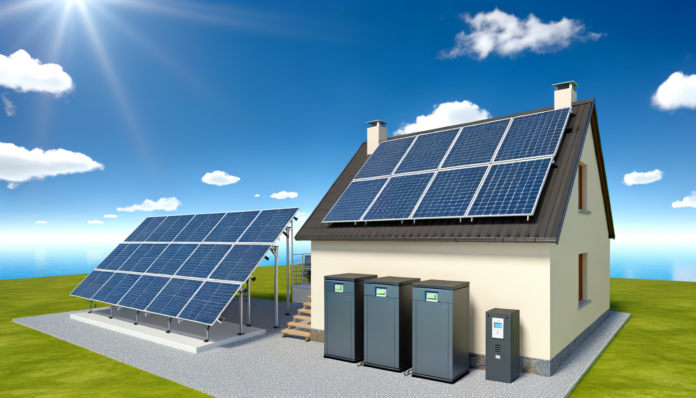Introduction to Solar Power Setups
Why Choose Solar Power?
Solar power has emerged as a leading renewable energy source, offering numerous advantages over traditional fossil fuels. One of the primary reasons to choose solar power is its environmental impact. Solar energy is clean and sustainable, reducing greenhouse gas emissions and dependence on non-renewable resources. Additionally, solar power can significantly lower electricity bills, providing long-term financial savings. With advancements in technology, solar panels have become more efficient and affordable, making them accessible to a broader audience.
Overview of Solar Power Systems
A solar power system is a complex assembly of various components working together to convert sunlight into usable electricity. The core components include:
- Solar Panels: These capture sunlight and convert it into direct current (DC) electricity.
- Inverters: Inverters convert the DC electricity generated by the panels into alternating current (AC) electricity, which is used by most household appliances.
- Charge Controllers: These regulate the voltage and current coming from the solar panels to the batteries, preventing overcharging and ensuring efficient energy storage.
- Batteries: Batteries store excess energy generated during the day for use at night or during cloudy periods.
- Mounting Systems: These secure the solar panels in place, either on rooftops or ground mounts.
- Cables and Connectors: These components link the system together, ensuring the smooth flow of electricity.
- Monitoring Systems: These provide real-time data on the system’s performance, helping to identify and troubleshoot issues.
Benefits of Solar Power for Outdoor Enthusiasts and Off-Grid Living
For outdoor enthusiasts and those interested in off-grid living, solar power offers unparalleled benefits. Here are some key advantages:
- Energy Independence: Solar power allows individuals to generate their own electricity, reducing reliance on the grid and providing energy security.
- Portability: Portable solar panels and battery packs are ideal for camping, hiking, and other outdoor activities, ensuring a reliable power source in remote locations.
- Cost Savings: By generating their own electricity, off-grid dwellers can avoid the high costs associated with extending power lines to remote areas.
- Environmental Impact: Using solar power reduces the carbon footprint, making it an eco-friendly choice for those who value sustainability.
- Low Maintenance: Solar power systems require minimal maintenance, making them a hassle-free option for those living off the grid.
In summary, solar power setups offer a sustainable, cost-effective, and reliable energy solution for a wide range of applications. Whether you’re looking to reduce your carbon footprint, save on electricity bills, or enjoy the freedom of off-grid living, solar power is a versatile and beneficial choice.
Solar Panels
Types of Solar Panels
Solar panels are the cornerstone of any solar power system, and they come in various types, each with its own set of advantages and disadvantages. The most common types are:
- Monocrystalline Solar Panels: These panels are made from a single, pure crystal of silicon. They are known for their high efficiency and sleek black appearance. Monocrystalline panels are ideal for installations where space is limited, as they generate more power per square foot compared to other types.
- Polycrystalline Solar Panels: These panels are made from multiple silicon crystals melted together. They are generally less efficient than monocrystalline panels but are more cost-effective. Polycrystalline panels have a distinctive blue hue and are a good option for larger installations where space is not a constraint.
- Thin-Film Solar Panels: These panels are made by depositing one or more layers of photovoltaic material onto a substrate. They are the least efficient but are lightweight and flexible, making them suitable for unconventional surfaces like curved roofs or portable applications.
How Solar Panels Work
Solar panels convert sunlight into electricity through a process known as the photovoltaic effect. Here’s a step-by-step breakdown of how it works:
- Photon Absorption: When sunlight hits the solar cells in a panel, photons (light particles) are absorbed by the silicon material.
- Electron Excitation: The absorbed photons excite electrons in the silicon, causing them to break free from their atoms.
- Electric Field Creation: The solar cell is designed with a positive and a negative layer, creating an electric field that directs the free electrons towards metal contacts on the cell.
- Current Generation: The movement of these electrons through the electric field generates direct current (DC) electricity.
- Inversion to AC: The DC electricity is then passed through an inverter to convert it into alternating current (AC), which is the type of electricity used by most household appliances.
Factors to Consider When Choosing Solar Panels
Selecting the right solar panels for your system involves several considerations:
- Efficiency: Higher efficiency panels generate more electricity from the same amount of sunlight, making them ideal for limited spaces.
- Cost per Watt: This metric helps you compare the cost-effectiveness of different panels. Divide the panel price by its wattage rating to get the cost per watt.
- Warranty: Look for panels with a long warranty period and favorable terms. Higher-quality panels often come with warranties that guarantee a certain level of performance over time.
- Size and Weight: The physical dimensions and weight of the panels can affect installation complexity and suitability for your specific location.
- Aesthetics: The appearance of the panels may be important, especially for residential installations. Monocrystalline panels offer a more uniform, sleek look compared to the blue hue of polycrystalline panels.
By understanding these key aspects, you can make an informed decision that maximizes the efficiency and cost-effectiveness of your solar power system.
Charge Controllers
Purpose of a Charge Controller
A charge controller is a crucial component in a solar power system, especially when batteries are involved. Its primary function is to regulate the voltage and current coming from the solar panels to the batteries, ensuring that the batteries are charged efficiently and safely. Without a charge controller, the batteries could be overcharged, leading to damage and reduced lifespan. Additionally, charge controllers prevent the batteries from discharging back into the solar panels during the night or periods of low sunlight.
Types of Charge Controllers
There are two main types of charge controllers used in solar power systems:
- PWM (Pulse Width Modulation) Charge Controllers: These controllers work by gradually reducing the power supplied to the batteries as they approach full charge. This method helps to maintain the batteries at a safe voltage level, preventing overcharging. PWM controllers are generally more affordable and are suitable for smaller solar power systems.
- MPPT (Maximum Power Point Tracking) Charge Controllers: MPPT controllers are more advanced and efficient compared to PWM controllers. They continuously monitor the voltage and current output of the solar panels and adjust the electrical load to ensure the maximum possible power is being transferred to the batteries. This type of controller is particularly beneficial in systems where the solar panel voltage is higher than the battery voltage, as it can convert excess voltage into additional current, thereby improving overall efficiency.
How to Choose the Right Charge Controller
Selecting the appropriate charge controller for your solar power system involves considering several factors:
- System Voltage: Ensure that the charge controller is compatible with the voltage of your solar power system. Common system voltages include 12V, 24V, and 48V.
- Current Rating: The charge controller must be able to handle the maximum current output from your solar panels. This is typically calculated by dividing the total wattage of your solar array by the system voltage and then adding a safety margin of 25-30%.
- Type of Solar Panels: If you are using high-voltage solar panels, an MPPT charge controller is recommended due to its ability to efficiently convert higher voltages to the battery voltage. For lower voltage systems, a PWM controller may suffice.
- Budget: While MPPT controllers offer higher efficiency, they are also more expensive. Consider your budget and the specific needs of your system when making a decision.
- Additional Features: Some charge controllers come with extra features such as temperature sensors, remote monitoring capabilities, and load control functions. These features can enhance the performance and usability of your solar power system.
In summary, a charge controller is essential for protecting and optimizing the performance of the batteries in a solar power system. By understanding the different types of charge controllers and the factors to consider when choosing one, you can ensure that your solar power setup operates efficiently and reliably.
Batteries
Types of Batteries Used in Solar Power Systems
Batteries are a crucial component in solar power systems, especially for off-grid setups or those requiring energy storage for use during non-sunny periods. There are three primary types of batteries used in solar power systems:
- Flooded Lead-Acid (FLA) Batteries: These are often referred to as “wet cell” batteries because the electrolyte is in liquid form. They require regular maintenance, including topping off with distilled water, and are best suited for users who can commit to monthly maintenance checks.
- Sealed Lead-Acid (SLA) Batteries: These batteries are maintenance-free and come in two types: Absorbent Glass Mat (AGM) and Gel. AGM batteries are more cost-effective and perform better in cold temperatures, while Gel batteries are better suited for high ambient temperatures.
- Lithium Batteries: Although more expensive upfront, lithium batteries offer longer lifespans, faster discharge and recharge rates, and are maintenance-free. They are modular, allowing for easy expansion of the battery bank as needed.
Battery Capacity and Efficiency
Battery capacity is measured in ampere-hours (Ah) or kilowatt-hours (kWh) and indicates how much energy the battery can store. Efficiency, on the other hand, refers to how well the battery can store and release energy. Here are some key points to consider:
- Depth of Discharge (DoD): This is the percentage of the battery’s capacity that can be used without significantly shortening its lifespan. For example, a battery with a 50% DoD can use half of its stored energy before needing a recharge.
- Round-Trip Efficiency: This measures the energy lost during the charging and discharging process. Lithium batteries typically have a higher round-trip efficiency (around 90-95%) compared to lead-acid batteries (around 70-80%).
- Cycle Life: This refers to the number of complete charge and discharge cycles a battery can undergo before its capacity falls below a certain percentage of its original capacity. Lithium batteries generally have a longer cycle life compared to lead-acid batteries.
Maintenance and Safety Tips for Solar Batteries
Proper maintenance and safety practices are essential for the longevity and safe operation of your solar batteries. Here are some tips:
- Regular Inspections: For FLA batteries, check the electrolyte levels monthly and top off with distilled water as needed. Inspect all battery types for signs of corrosion, leaks, or damage.
- Proper Ventilation: Ensure that the battery storage area is well-ventilated to prevent the buildup of gases, especially for lead-acid batteries, which can emit hydrogen gas during charging.
- Temperature Control: Batteries perform best within a specific temperature range. Extreme temperatures can reduce battery efficiency and lifespan. Consider using temperature-controlled environments or battery heaters/coolers if necessary.
- Safety Precautions: Always wear protective gear, such as gloves and safety glasses, when handling batteries. Keep a fire extinguisher nearby and ensure that the battery area is free from flammable materials.
- Regular Testing: Periodically test the battery’s voltage and capacity to ensure it is functioning correctly. Replace batteries that show significant drops in performance.
By understanding the types of batteries available, their capacity and efficiency, and adhering to proper maintenance and safety practices, you can ensure that your solar power system operates efficiently and reliably.
Inverters
Role of an Inverter in a Solar Power System
Inverters are the brains of a solar power system. Their primary role is to convert the direct current (DC) electricity generated by solar panels into alternating current (AC) electricity, which is the standard form of electricity used by household appliances and the electrical grid. Without an inverter, the DC electricity produced by the solar panels would be unusable for most home applications. In addition to conversion, inverters also manage the flow of electricity between the solar panels, batteries, and the grid, ensuring that the system operates efficiently and safely.
Types of Inverters
There are several types of inverters available, each suited to different system configurations and needs:
- String Inverters: These are the most common and cost-effective type of inverters. A string inverter is a central unit that connects to a series of solar panels (a string). They are ideal for installations where all panels receive uniform sunlight. However, if one panel in the string is shaded, the performance of the entire string is affected.
- String Inverters with Power Optimizers: Power optimizers are small devices attached to each solar panel. They optimize the output of each panel individually, mitigating the impact of shading on the overall system. This setup allows for panel-level monitoring and improved performance in partially shaded conditions.
- Microinverters: Microinverters are installed on each solar panel, converting DC to AC at the panel level. This setup allows for maximum energy harvest from each panel, even if some panels are shaded or dirty. Microinverters also offer panel-level monitoring and are more flexible for system expansion.
- Storage-Ready Inverters: These inverters are designed to work with battery storage systems. They can manage the charging and discharging of batteries, making them ideal for off-grid or hybrid systems that combine solar power with grid electricity.
Choosing the Right Inverter for Your Needs
Selecting the right inverter depends on several factors, including your system size, budget, and specific site conditions:
- System Size and Budget: For smaller, budget-conscious installations, string inverters are often the best choice due to their lower cost. However, for larger systems or those with complex layouts, microinverters or string inverters with power optimizers may offer better performance and flexibility.
- Shading and Orientation: If your installation site has shading issues or panels facing different directions, microinverters or string inverters with power optimizers are recommended. These options ensure that shading on one panel does not affect the performance of the entire system.
- Future Expansion: If you plan to expand your system in the future, microinverters offer the most flexibility. Each panel operates independently, making it easy to add more panels without reconfiguring the entire system.
- Battery Integration: If you intend to add battery storage, choose a storage-ready inverter. These inverters are designed to manage both solar power generation and battery storage, providing a seamless integration for hybrid systems.
In conclusion, the inverter is a critical component of any solar power system, responsible for converting DC to AC electricity and managing the flow of power. Understanding the different types of inverters and their specific applications will help you choose the best option for your solar power setup, ensuring optimal performance and efficiency.
Additional Components and Accessories
Mounting Systems
Mounting systems are essential for securing solar panels in place, whether on rooftops, the ground, or other structures. The choice of mounting system can significantly impact the efficiency and longevity of your solar power setup. Here are the primary types of mounting systems:
- Roof Mounts: These are the most common type of mounts used in residential solar installations. Roof mounts attach solar panels directly to the roof of a building, utilizing the existing structure for support. They are cost-effective and save valuable ground space. However, they require a roof in good condition and may involve additional costs for roof repairs or reinforcements.
- Ground Mounts: Ground mounts are standalone structures built from metal pipes and concrete footings. They offer greater flexibility in panel orientation and tilt, allowing for optimal sunlight capture. Ground mounts are easier to access for maintenance but require more space and a higher initial investment compared to roof mounts.
- Pole Mounts: These mounts elevate solar panels on a single pole, making them ideal for areas with heavy snowfall or steep terrain. Pole mounts can be adjusted to different angles to maximize sunlight exposure and are easier to install on uneven ground. However, they are less common and generally more expensive than other mounting options.
- Ballasted Mounts: Ballasted systems use heavy materials like gravel or concrete to hold the panels in place without the need for ground penetration. These are ideal for flat roofs or temporary installations. They are quick to install but may not be suitable for areas with high wind speeds.
Cables and Connectors
Cables and connectors are the lifelines of a solar power system, ensuring the efficient transfer of electricity between components. Proper selection and installation of these elements are crucial for system performance and safety.
- PV Wires: These are specialized cables designed to handle the high voltage and current produced by solar panels. They are typically made of copper or aluminum and are insulated to withstand harsh environmental conditions.
- Connectors: Connectors, such as MC4 connectors, are used to link solar panels together and connect them to other system components. They are designed to be weatherproof and provide a secure, reliable connection.
- Combiner Boxes: These boxes consolidate the output from multiple solar panel strings into a single output, simplifying the wiring and reducing the number of cables running to the inverter.
- Junction Boxes: Junction boxes are used to house electrical connections, protecting them from the elements and preventing short circuits.
Monitoring Systems
Monitoring systems are vital for tracking the performance and health of your solar power setup. They provide real-time data on energy production, system efficiency, and potential issues, allowing for timely maintenance and optimization.
- Inverter-Based Monitoring: Many modern inverters come with built-in monitoring capabilities, providing data on energy production and system performance. This information can often be accessed via a web portal or mobile app.
- Standalone Monitoring Systems: These systems offer more detailed analytics and can monitor individual panel performance. They are particularly useful for larger installations or systems with multiple inverters.
- Energy Meters: Energy meters measure the amount of electricity generated by your solar panels and the amount consumed by your household. This data is crucial for optimizing energy usage and maximizing savings.
- Environmental Sensors: These sensors measure factors like temperature, sunlight intensity, and wind speed, providing additional data to help optimize system performance.
In summary, the additional components and accessories in a solar power setup—mounting systems, cables and connectors, and monitoring systems—play crucial roles in ensuring the efficiency, safety, and longevity of the system. Proper selection and installation of these elements are essential for maximizing the benefits of solar energy.
Setting Up and Maintaining Your Solar Power System
Step-by-Step Guide to Setting Up a Solar Power System
Setting up a solar power system can seem daunting, but breaking it down into manageable steps can simplify the process. Here’s a step-by-step guide to help you get started:
1. **Assess Your Energy Needs**: Calculate your household’s energy consumption to determine the size of the solar power system you need.
2. **Site Evaluation**: Choose an optimal location for your solar panels, considering factors like roof orientation, shading, and available space.
3. **Select Components**: Choose the right solar panels, inverters, batteries, and mounting systems based on your energy needs and site conditions.
4. **Design the System**: Plan the layout of your solar array, ensuring that all components are compatible and optimally positioned.
5. **Obtain Permits**: Check local regulations and obtain necessary permits for installing a solar power system.
6. **Install Mounting System**: Secure the mounting system to your roof or ground, ensuring it is properly aligned and anchored.
7. **Install Solar Panels**: Attach the solar panels to the mounting system, connecting them in series or parallel as per your design.
8. **Wiring**: Connect the solar panels to the inverter and then to your home’s electrical system. Ensure all connections are secure and comply with electrical codes.
9. **Install Inverter and Batteries**: Set up the inverter and batteries (if applicable), ensuring they are properly connected and configured.
10. **System Testing**: Test the entire system to ensure it is functioning correctly and efficiently.
11. **Grid Connection**: If you are connecting to the grid, coordinate with your utility company to complete the connection and set up net metering.
Common Issues and Troubleshooting Tips
Even with careful planning and installation, you may encounter some common issues with your solar power system. Here are a few troubleshooting tips:
– **Low Power Output**: Check for shading on the panels, dirt accumulation, or faulty connections. Clean the panels and ensure all connections are secure.
– **Inverter Issues**: If the inverter is not working, check for error codes and consult the manual. Ensure it is properly connected and ventilated.
– **Battery Problems**: If batteries are not charging or discharging correctly, check the charge controller settings and battery connections. Ensure the batteries are not damaged or degraded.
– **Monitoring System Errors**: If your monitoring system shows errors, check the internet connection and ensure all components are properly linked.
Regular Maintenance Practices
Regular maintenance is crucial to ensure the longevity and efficiency of your solar power system. Here are some best practices:
– **Panel Cleaning**: Clean the solar panels regularly to remove dust, dirt, and debris. Use a soft brush and water to avoid scratching the surface.
– **Inspect Connections**: Periodically check all electrical connections for signs of wear or corrosion. Tighten any loose connections.
– **Monitor Performance**: Use your system’s monitoring tools to track performance and identify any drops in efficiency. Address issues promptly.
– **Battery Maintenance**: For lead-acid batteries, check electrolyte levels and top up with distilled water as needed. Ensure all batteries are properly ventilated.
– **Inverter Check**: Inspect the inverter for any error messages or unusual noises. Ensure it is free from dust and has adequate ventilation.
– **Professional Inspection**: Schedule an annual inspection by a professional to ensure all components are in good working order and to address any potential issues.
By following these steps and maintenance practices, you can ensure that your solar power system operates efficiently and reliably for many years.






